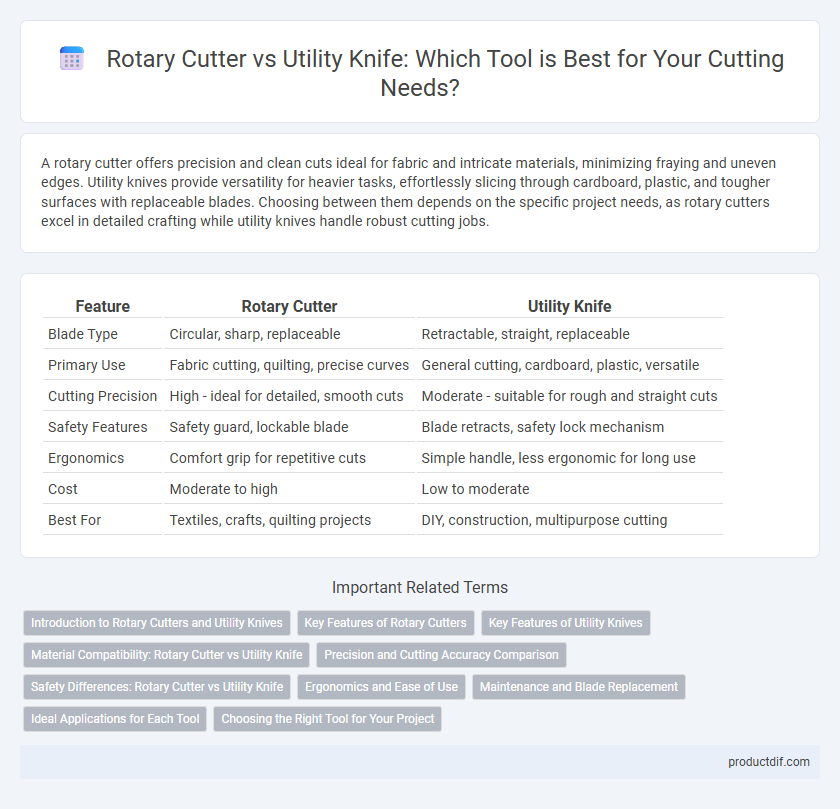A rotary cutter offers precision and clean cuts ideal for fabric and intricate materials, minimizing fraying and uneven edges. Utility knives provide versatility for heavier tasks, effortlessly slicing through cardboard, plastic, and tougher surfaces with replaceable blades. Choosing between them depends on the specific project needs, as rotary cutters excel in detailed crafting while utility knives handle robust cutting jobs.
Table of Comparison
| Feature | Rotary Cutter | Utility Knife |
|---|---|---|
| Blade Type | Circular, sharp, replaceable | Retractable, straight, replaceable |
| Primary Use | Fabric cutting, quilting, precise curves | General cutting, cardboard, plastic, versatile |
| Cutting Precision | High - ideal for detailed, smooth cuts | Moderate - suitable for rough and straight cuts |
| Safety Features | Safety guard, lockable blade | Blade retracts, safety lock mechanism |
| Ergonomics | Comfort grip for repetitive cuts | Simple handle, less ergonomic for long use |
| Cost | Moderate to high | Low to moderate |
| Best For | Textiles, crafts, quilting projects | DIY, construction, multipurpose cutting |
Introduction to Rotary Cutters and Utility Knives
Rotary cutters feature a circular blade designed for smooth, precise cutting of fabric and paper, making them ideal for quilting and crafting projects. Utility knives, equipped with a retractable straight blade, offer versatility for general-purpose cutting tasks such as opening boxes, trimming materials, and scoring surfaces. Both tools provide reliable cutting solutions, but their specific blade shapes and handling styles cater to different applications and user needs.
Key Features of Rotary Cutters
Rotary cutters feature a circular, sharp blade designed for precise, straight cuts on fabric, paper, and leather, offering superior control and efficiency compared to utility knives. Their ergonomic handles reduce hand fatigue, making them ideal for repetitive cutting tasks in quilting and sewing projects. Unlike utility knives, rotary cutters often include safety guards and blade-locking mechanisms to prevent accidental injuries during use.
Key Features of Utility Knives
Utility knives offer a retractable blade design that enhances safety and portability, making them suitable for various cutting tasks such as slicing cardboard, trimming vinyl, and scoring drywall. Their replaceable blades ensure long-lasting sharpness, providing precision and ease in detailed work compared to rotary cutters. The ergonomic handle design of utility knives delivers a comfortable grip, reducing hand fatigue during extended use.
Material Compatibility: Rotary Cutter vs Utility Knife
Rotary cutters excel in cutting fabric, leather, and thin vinyl with precision and minimal fraying, making them ideal for textiles and craft materials. Utility knives are versatile for tougher materials like cardboard, plastic, and thicker leather due to their sturdier blades and adjustable depth. Choosing between a rotary cutter and a utility knife depends on the material's thickness and required cutting accuracy.
Precision and Cutting Accuracy Comparison
Rotary cutters excel in precision and cutting accuracy when working with fabrics and layered materials due to their circular blade that glides smoothly without shifting the material. Utility knives offer versatility but may sacrifice exactness, especially on detailed cuts, as their straight blades can slip or create uneven edges. For projects demanding consistently clean, precise cuts, rotary cutters provide superior control and accuracy compared to utility knives.
Safety Differences: Rotary Cutter vs Utility Knife
Rotary cutters feature a circular blade that retracts automatically, minimizing accidental cuts and enhancing user safety compared to utility knives, which have exposed straight blades prone to slips and injuries. The rotary cutter's ergonomic design reduces hand fatigue and promotes controlled, smooth cutting motions, whereas utility knives require firmer grips and precise handling to avoid accidents. Safety mechanisms like blade guards and locking features are more commonly integrated in rotary cutters, providing an added layer of protection not always present in utility knives.
Ergonomics and Ease of Use
Rotary cutters feature an ergonomic handle designed to reduce hand fatigue during extended use, making them ideal for cutting fabric and soft materials with precision. Utility knives often have a more compact grip suited for controlled, detailed cutting tasks but may cause strain when used for prolonged periods. Both tools offer ease of use, though rotary cutters excel in comfort and smooth slicing, while utility knives provide versatility for tougher materials.
Maintenance and Blade Replacement
Rotary cutters require regular blade sharpening or replacement to maintain clean, precise cuts, with blades often lasting longer due to circular motion reducing wear. Utility knives feature easily replaceable snap-off or retractable blades, allowing for quick maintenance without tools but often needing more frequent changes due to straight-line cutting. Proper cleaning and blade storage extend blade life for both tools, optimizing performance and safety during use.
Ideal Applications for Each Tool
Rotary cutters excel in fabric cutting, quilting, and crafting, providing precise, clean cuts through multiple layers with minimal effort. Utility knives are ideal for general-purpose tasks such as cutting cardboard, carpet, vinyl, and drywall, offering versatility and easy blade replacement for various materials. Choosing between a rotary cutter and a utility knife depends on the material type, thickness, and the precision required for the project.
Choosing the Right Tool for Your Project
Rotary cutters provide precise, clean cuts ideal for fabric, leather, and thin materials, ensuring smooth edges without fraying, making them essential for quilting and sewing projects. Utility knives offer versatility with replaceable blades suitable for heavier tasks like cutting cardboard, plastic, and carpet, delivering strength and durability for construction or DIY work. Selecting the right tool depends on material type, required precision, and project scale, where rotary cutters excel in detailed, delicate work and utility knives handle robust, varied cutting needs effectively.
Rotary Cutter vs Utility Knife Infographic

 productdif.com
productdif.com